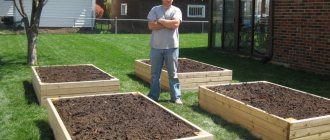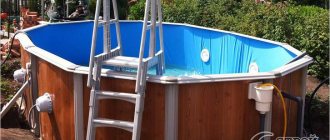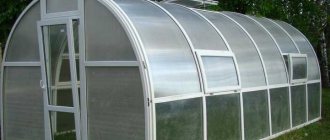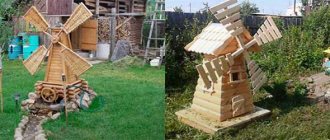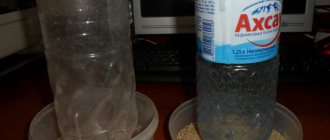Cheap heating for a greenhouse. The cheapest and most efficient heating of a greenhouse in the off-season
Gardeners and vegetable gardeners are no strangers to frosts in the off-season. If the greenhouse is not heated with electricity, you have to resort to additional means of protecting the seedlings from death. One of the simplest and at the same time effective means that has the right to exist is heating a greenhouse with a liquid candle. Perhaps this is the oldest and easiest way to help seedlings survive frosts. Making a candle is not difficult; its efficiency is quite high, and its cost is extremely cheap.
To create a liquid candle you will need:
- the thinnest possible candle with the thickest natural wax wick;
- sunflower oil (the oil should not be the cheapest, otherwise soot will form on the wick);
- any glass/iron container (jar, glass, etc.);
- for reliable fixation - alabaster (or any other building mixture).
Let's start creating a candle:
1. Pour alabaster or any other building mixture suitable for this purpose onto the bottom of the container. This is necessary in order to fix the candle in the glass/jar. Later, when the candle burns out, you can pour warm water, remove the candle and insert a new one. Thus, the action with alabaster is one-time.
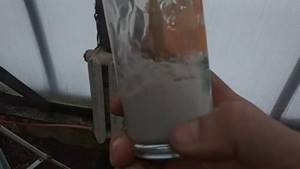
Youtube | UNDERTHAL
Heating a greenhouse with candles is a simple and fairly common method. The heating structure is made independently from available materials.
2. As soon as the alabaster hardens a little, insert a candle and wait for maximum hardening. Next, add sunflower oil to the top. Do not use oil that is too cheap, as the wick may become sooted and have an unpleasant odor (or even go out).
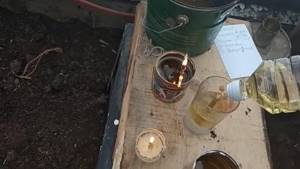
Youtube | UNDERTHAL
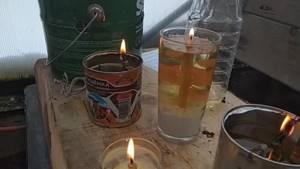
Youtube | UNDERTHAL
3. Next, such a candle can simply be left on the table or placed in a bucket with holes drilled around the perimeter. Two or three of these buckets with liquid candles can heat a small greenhouse during the off-season frost. By the way, to save money, you can make one that will burn for more than 100 hours.
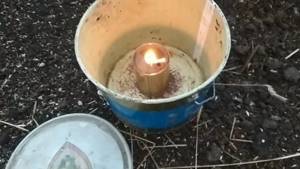
Heating the greenhouse with candles. How to heat a small room, tent, greenhouse with one candle?
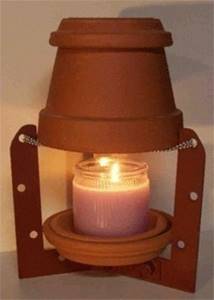
We all know how much heat it takes to warm a cold house on a winter day. However, modern inventors are constantly coming up with new devices that can significantly save resources and effort. An example of such an invention would be a miniature stove powered by a single candle.
Most likely, such a stove will not be able to heat a large room on a frosty day. Here you will need to organize a full-fledged heating system, for example, think through electric heating schemes. But for heating a tent during a hike or even a greenhouse, the power of this stove will be quite enough.
This amazing device was invented by a Californian named Doyle Doss. It is put on stream and is called “Candle Heater” or in the original “Kandle Heeter”. The heater is quite successfully sold on the American market for $25 apiece. You can do it yourself using the diagram below.
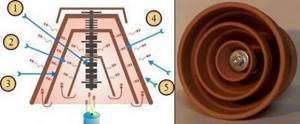
To create such a heater, you will need:
Candle base; Three ceramic flower pots of different diameters; Metal bolt and set of metal washers and nuts; Supports for pots; Candle.
So, the pots need to be placed one inside the other and connected with a metal bolt with washers and nuts threaded onto it as shown in the heater diagram. Place the candle on the stand and secure the finished structure to the supports above the candle. The heater is ready.
Now all the heat from the burning candle will not be wasted, but will serve to heat the room. By heating the metal rod and air in ceramic pots, the candle thus completely transfers its heat to heat the room. In the end, it turns out that there is a lot of it. Probably not enough for a room in a big house. But for a tent, greenhouse, hallway or bathroom - it’s quite enough. An additional bonus will be the absence of soot on the ceiling (it remains in a small pot and can be washed out), as well as the lighting of the room from candle light. A very convenient option during power outages.
Air heating
This method involves the use of heating and ventilation tools. For the required structure to function, you need to install a steel pipe, which will be located at one end inside the greenhouse, and at the other end it will go outside.
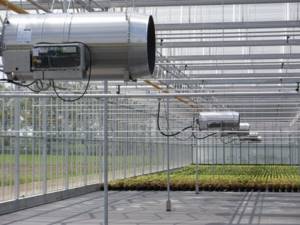
To use this method in winter, it is necessary to light fires to heat the pipe, which is a fire hazard.
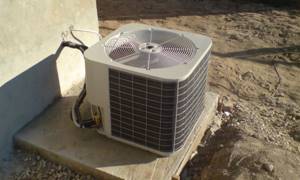
How to heat a greenhouse with a candle. Why is heating used in greenhouses?
If you heat shelters for growing crops, this will help to significantly extend the period of harvesting, and will also allow you to harvest the earliest possible harvest. Well-established heating will allow you to grow plants all year round and get several harvests.
In this case, it is best to use a permanent greenhouse and install heating in it. In this case, it is necessary to organize automatic control or constantly monitor the process.
Such systems can help in growing heat-loving exotic crops in regions with harsh climates.
It will be important to install a heater in a cold greenhouse in climates with short summers or changeable springs with recurrent frosts.
Important! When choosing a heater for a winter greenhouse, you should take into account the parameters of the greenhouse and climatic conditions, the power and efficiency of the device, and the budget. We should also not forget that the cost of vegetables grown in shelters should not be higher than the cost of heating.
When and how to use
It makes sense to use heaters at such times:
- In the spring. It is used for earlier planting of seedlings or sowing seeds for seedlings, while taking into account the characteristics of the crops being grown. For example, the minimum soil temperature for tomato seeds to germinate is +10°C, but at +16°C they will sprout faster. For normal development of seedlings, the air temperature at night should not be below +15°C, and temperatures below +12°C are generally undesirable. Such heat-loving crops are planted when the soil warms up to +10...+12°C. And radishes and greens sprout already at +3...+5°C. In sheltered areas, the soil temperature is usually only a few degrees warmer than in open beds.
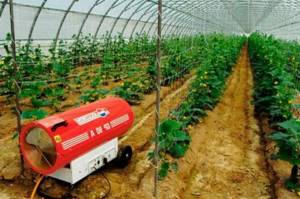
If you use heaters, then all sowing or planting work can be done earlier. As the weather warms up, heating can only be left on overnight. But you shouldn’t get carried away with it so that the temperature difference necessary for the crops remains. - In summer. Sometimes even in summer, in some regions temperatures drop to critical levels. But usually there is no need for heating at this time in protected ground.
- In autumn. When temperatures begin to decline and the nights become colder, heating at night becomes important.
- In winter. It is very important during the cold period to constantly maintain the required conditions for growing crops. The use of heaters makes sense in capital or well-sealed rooms with well-established lighting and the use of automation. Not every device can handle this.
The most economical greenhouse heating. Heating options and methods
Experienced gardeners share their inventions and experience in using commercially available devices for heating a film greenhouse. The most common of them include the following:
- stove heating;
- water heating from a boiler;
- use of a gas gun;
- IR heaters and convectors;
- heating the soil using cables or water pipes.
The possibility of using one or another method of heating a greenhouse depends on having access to an appropriate source of thermal energy. For example, when creating a water heating system for a greenhouse with walls made of polycarbonate or film, access to a central water supply is required. The type of fuel for operating the boiler can be any: gas, electric, liquid or solid fuel.
Each of the above methods of heating a greenhouse has its own advantages and disadvantages. The use of gas guns is considered quite effective and resource-saving, gas consumption is minimal. When choosing guns, the area of the rectangular space of the greenhouse and the required power are taken into account.
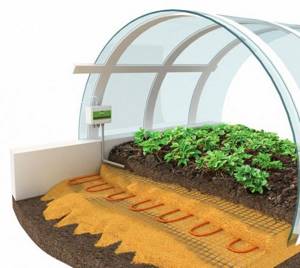
If we consider electric as the main source of energy, it is best to purchase an infrared heater. Such a system effectively increases the temperature of the air space in the room, without drying out the air and the plants themselves.
In addition to IR heaters, infrared films are used to heat the soil. For plant growth and maturation, soil heating is most important. The film is easy to install with your own hands; it is placed under the ground, thereby heating the soil and the air above it. The disadvantage is the need for electrical wiring.
The stove device is considered an economical way to heat a greenhouse. The disadvantage of this option is the need to manually maintain the desired temperature in the oven. In addition, stoves dry the air space of greenhouses.
Types of heating systems
Many summer residents and residents of rural areas use greenhouses only in the relatively warm season, but if desired, they can also be equipped for year-round use.
There are several types of heating systems.
Steam
If the greenhouse is located in close proximity to the house (no further than 10 meters) or is even adjacent to the wall, then conventional steam heating can be installed: pipes are routed inside and the room is arranged like a regular residential one. In addition, it is advisable to make a warm floor. To do this, the pipes are placed directly underground so that the circuit evenly heats the usable area of the soil.
This type of system can affect the overall heating of the home, so care must be taken not to worsen living conditions. It is important to consider whether the boiler’s power is sufficient, whether it will “pull” additional load or whether it will be necessary to install another, additional one. If the greenhouse is not very close to the house, significant losses during heat transportation are possible.
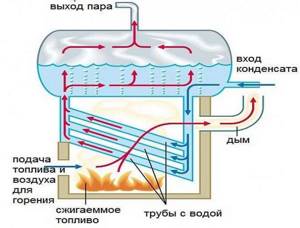
Air
One common method is air heating. In order for the temperature to be sufficient not only in space, but also in the soil, it requires proper design of the structure itself. In many greenhouses, even without additional heating, building insulation materials are used for this purpose.
With this method, the air is heated by the following equipment:
- heat guns;
- ovens;
- convectors;
- boilers.
Guns, in turn, are divided according to the type of heating (direct or indirect) and the type of fuel used.
There are guns:
- solid fuel;
- electrical;
- diesel;
- water:
- gas;
- multi-fuel.
When choosing, you should pay attention to such characteristics as power (indicated in kilowatts) and heating area. The principle of operation is the same for all; you will need a heating element and a fan that passes air flow through it.
The next method is heating with gas stoves, operating on the principle of a conventional “potbelly stove”. Unlike boilers, the furnace is not connected to the heating main. It can operate both from a gas pipeline and from cylinders.
Air heating boilers are a cross between a stove and a regular boiler. Unlike them, such a boiler has a fan that carries out heat exchange using the so-called forced convection method. That is, it distributes heated air. Unlike the main boiler, the air boiler is not connected to pipelines.
Another option is to use convectors, which are divided into wall-mounted and floor-mounted. There are other options, but they are suitable mainly for residential premises and offices, but not for a greenhouse.
Convectors can also operate on different fuels; moreover, they can be built into the heating system with boilers.
Pros:
- relatively low cost;
- fast heating;
- safety;
- noiselessness.
In addition, convectors do not burn or dry air and do not require special care. Gas engines are characterized by low fuel costs.
Minuses:
- small heating area;
- the need for wiring and coordination for gas boilers;
- high cost of electricity - for electric ones.
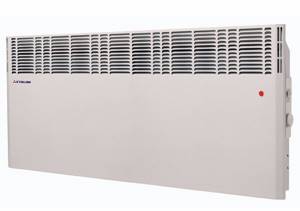
Mermen
Water boilers operate on a principle similar to a stove; they are usually connected to a gas pipeline, but transfer heat to a pipeline with a coolant, which is often water. Thus, a local boiler room is obtained, with its own mains and heating radiators, capable of heating fairly large areas, including greenhouses.
Water heating is most effective if the greenhouse is an extension and there is no need to conduct communications in an open area.
The solid fuel modification runs on wood or coal. The obvious disadvantage of such equipment is the difficulty of maintaining constant heating. Even in long-burning models, one bookmark lasts no more than 16 hours.
This is not the cheapest heating method: taking into account the efficiency (efficiency factor), equipment and installation costs, firewood can cost twice as much as gas per season. On the other hand, solid fuel is more accessible - gas pipelines are not available everywhere in rural areas. Moreover, eco-pea coal may not cost much, but is still cheaper than gas.
Heating with infrared heaters and heating cables
Infrared heaters are also used to heat greenhouses. Their main structural element is the emitter. The principle of operation is that it does not heat the air, but the surrounding objects, which, in turn, give off heat to the air.
Such heaters are divided according to the type of energy source.
There are:
- electrical;
- gas;
- water;
- diesel
One of the advantages of such devices is that they can heat directionally, that is, not the entire room, but a local part of it. The heater is directed to some element of the greenhouse, for example, to a concrete path between rows or to a wall (if it is stone or concrete), which subsequently serves as a heat accumulator. That is, it warms up and releases heat into the air.
Quite often, infrared emitters are combined with heating cables. A sand cushion is built under the soil layer into which the cable is laid. The power source can be a regular electrical network. Laying is done in such a way that the entire area is heated evenly. Warming the earth is more effective and allows you to reduce the heating of the air, which has a beneficial effect on crops.
Prices for different types of infrared heaters
infrared heater
The economic benefit of using these types is due to fuel costs. It is advisable to use thermostats, especially since different types of plants require their own heating modes.
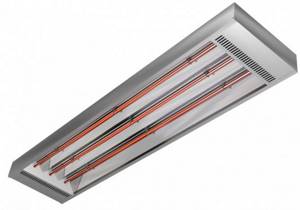
Prices for heating cables
heating cable
